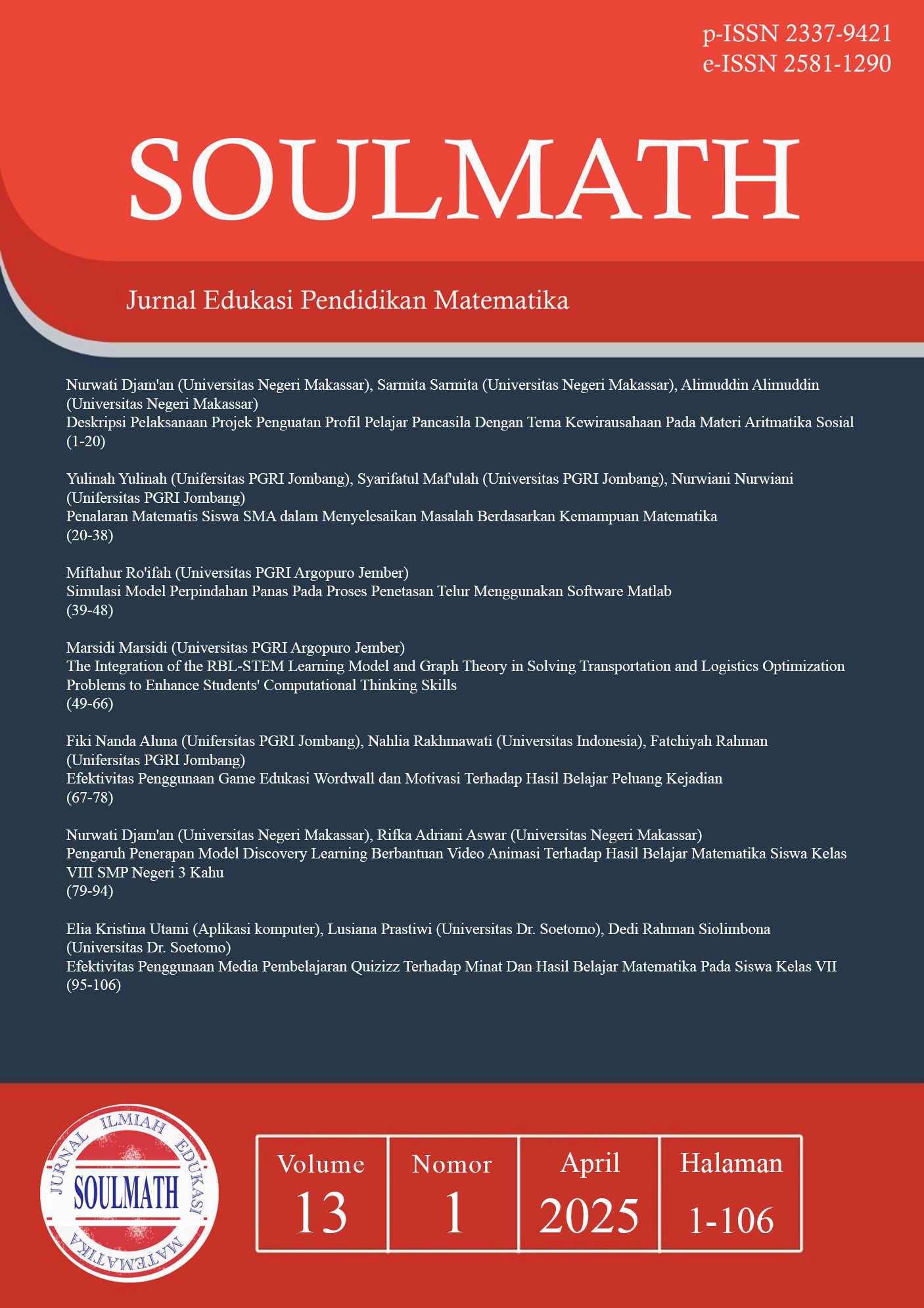The Integration of the RBL-STEM Learning Model and Graph Theory in Solving Transportation and Logistics Optimization Problems to Enhance Students' Computational Thinking Skills
 Abstract views: 39
,
Abstract views: 39
,
 10025 Publish downloads: 25
10025 Publish downloads: 25
Abstract
Abstract
This study aims to integrate the Research-Based Learning (RBL) model with the STEM approach and graph theory in solving transportation and logistics optimization problems to enhance students’ computational thinking skills. The model is designed to train students in identifying transportation and logistics issues, exploring solutions based on graph theory, and analyzing and optimizing distribution routes using algorithms such as Dijkstra and Floyd-Warshall. This research employs a narrative qualitative method, analyzing research-based learning through six RBL-STEM phases: problem identification, initial solution exploration, data collection, data analysis, result interpretation, and model presentation. The results show that this approach significantly improves students’ skills in problem decomposition, pattern recognition, algorithmic thinking, and abstraction in solving real-world problems. Concretely, students demonstrated an average score improvement of 23% in computational thinking indicators after participating in the learning process, particularly in designing optimal route graph models and constructing algorithmic logic for route selection. Moreover, the use of technologies such as Google Maps and graph modeling software enables students to perform real-time data-driven analysis. Therefore, this study proves that the integration of RBL-STEM and graph theory not only enhances conceptual understanding of transportation and logistics optimization but also equips students with applicable computational thinking skills for real-world contexts. This learning model can serve as a reference in developing more innovative and industry-relevant STEM-based teaching strategies.
Keywords: RBL-STEM; Graph; Transportation; Logistics; Computational Thinking Skill.
Downloads
References
Mono Castañeda, A. (2023). Computational thinking for a 5.0 society. Revista Tecnología, Ciencia y Educación, 25, 111-140.
Cansu, F. K., & Cansu, S. K. (2019). An overview of computational thinking. International Journal of Computer Science Education in Schools, 3(1), 17-30.
Sentriyo, I., Sumarna, N., Rabani, L., & Arisanti, W. O. L. (2023). Integration of Digital Technology in the Learning Process Through Problem-Based Learning Models. AL-ISHLAH: Jurnal Pendidikan, 15(2), 2266-2274.
Lu, K., Pang, F., & Shadiev, R. (2021). Understanding the mediating effect of learning approach between learning factors and higher order thinking skills in collaborative inquiry-based learning. Educational Technology Research and Development, 69(5), 2475-2492.
Kristiana, A. I., Ridlo, Z. R., Prihandini, R. M., & Adawiyah, R. (2022). The Research Based Learning--STEM Learning Activities: The Use of r-Dynamic Coloring to Improve the Students Metaliteracy in Solving a Tessellation Decoration Problem. arXiv preprint arXiv:2203.11673.
Alpian, Y., Maryati, T. K., Kadir, D., & Agustin, I. H. (2023). RBL-STEM Learning Activity Framework: The Development of Paving Block Decorations Using Local Antimagic Coloring Techniques in Improving Students’ Conjecturing Thinking Skills. International Journal of Current Science Research and Review, 6(1).
Ghosh, S., Mallick, A., Chowdhury, A., De Sarkar, K., & Mukherjee, J. (2024). Graph theory applications for advanced geospatial modelling and decision-making. Applied Geomatics, 16(4), 799-812.
Hidayat, R., Juniati, D., & Khabibah, S. (2023). Studi Literatur: Computational Thinking Dalam Penyelesaian Soal Cerita. Jurnal Ilmiah Soulmath: Jurnal Edukasi Pendidikan Matematika, 12(1), 01-12.
Wang, Z., Li, Y., Shen, L., & Huang, H. (2024). A unified and general framework for continual learning. arXiv preprint arXiv:2403.13249.
Polat, E., Hopcan, S., Kucuk, S., & Sisman, B. (2021). A comprehensive assessment of secondary school students’ computational thinking skills. British Journal of Educational Technology, 52(5), 1965-1980.
Azizah, N. L. (2018). Aplikasi Metode Transportasi dalam Optimasi Biaya Distribusi Beras Sejahtera pada Perum Bulog Sub-Divre Sidoarjo. Jurnal Ilmiah Soulmath: Jurnal Edukasi Pendidikan Matematika, 6(1), 15-23.
Tsarava, K., Moeller, K., Román-González, M., Golle, J., Leifheit, L., Butz, M. V., & Ninaus, M. (2022). A cognitive definition of computational thinking in primary education. Computers & Education, 179, 104425.
Hariyadi, S., Rofiâ, A., Santosa, T. A., & Sakti, B. P. (2023). Effectiveness of STEM-based mind mapping learning model to improve students' science literacy in the era of Revolution 4.0. Jurnal Penelitian Pendidikan IPA, 9(10), 791-799.
Jannah, E. S. W., Dafik, A. I. K., & Kristiana, A. I. (2024). The Development of RBL-STEM Learning Materials to Improve Students’ Information Literacy in Solving Rainbow Antimagic Coloring Problem for ETLE Technology. International Journal of Current Science Research and Review, 7(01).
Dare, E. A., Keratithamkul, K., Hiwatig, B. M., & Li, F. (2021). Beyond content: The role of STEM disciplines, real-world problems, 21st century skills, and STEM careers within science teachers’ conceptions of integrated STEM education. Education Sciences, 11(11), 737.
Sumarno, Gimin, Noviana, E., Dafik, Ridlo, Z. R., & Mursyidah, I. L. (2024). The Analysis of the RBL-STEM Application in Improving Student Financial Literacy in Controlling Consumptive Behavior. Heliyon.
Marsidi, M., Dafik, D., Susanto, S., & Kristiana, A. I. (2024, December). RBL-STEM learning activity framework: Improving students' combinatorial thinking skills for solving image encryption problems using edge irregular reflexive k-labeling. In AIP Conference Proceedings (Vol. 3148, No. 1). AIP Publishing.







